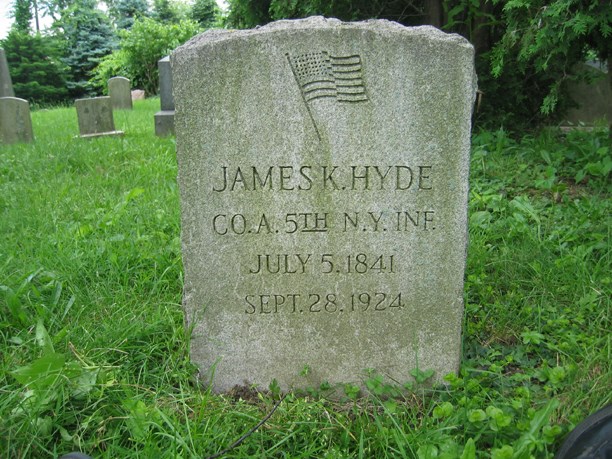Last updated: January 10, 2022
Article
Civil War Soldier Buried at St. Paul’s fought with two Zouave regiments and served with Commissary

National Park Service
Civil War Soldier Buried at St. Paul’s fought with two Zouave regiments and served with the Commissary
James Hyde served with two distinctly uniformed regiments in the Civil War, while also helping to feed the Union troops. After returning to civilian life, he worked on some of New York City’s earliest highways before passing in 1923, an octogenarian, followed by interment at the St. Paul’s cemetery.An urgent recruitment drive in the summer of 1862, required because of Confederate victories in the Virginia fighting of May through August, gathered many volunteers from the St. Paul’s area, including Hyde, who was 22, living with his parents and many siblings. While most of these young men enrolled in newly formed units, he enlisted for three years on August 19 with the 5th New York Volunteer Infantry, which incurred heavy losses at the Battles of the Seven Days. Hyde was likely captivated by the regiment’s characteristic Zouave appearance, modeled on the legendary Algerian fighters, generating a maverick reputation. Even in the 19th century, prior to the emergence of mass media, daily newspapers and periodicals spread the word about the charismatic infantry unit. James was the sole Hyde out of five brothers (three older and one younger) to volunteer for the military campaign to preserve the Union, indicating a level of family disagreement over the war.
The raw, grey-eyed Westchester County native joined the fighting at one of the critical stretches of the great national conflict, marching through fields and along dirt roads in Zouave baggy red pants and open blue shirts. The fez turban pulled down over his brown hair. Enrolling in a regiment that had sustained considerable casualties, Hyde underwent minimal training after issuance of his rifled musket and rapid integration into the ranks, instructed at the front by veterans of Company A.
Private Hyde reached the unit just after heavy losses at the Second Battle of Bull Run, August 30. While the Zouaves were held in reserve at Antietam, the costliest day of the Civil War, Hyde fought at the Union defeat at Fredericksburg in mid December, and following winter camp, clashed at Chancellorsville in early May 1863, when the regiment collided with lead elements of Stonewall Jackson’s brigade. That Virginia battle, a major Southern victory, terminated the scheduled two-year life of the 5th. The five-foot, fiveinch private was one of 230 recruits transferred to the 146th New York Volunteers to complete their three year enlistments. Infused with many soldiers from the 5th, the 146 adopted a version of the Zouave uniform.
Within two months of integrating the Zouave veterans, the 146th fought at the critical Battle of Gettysburg, helping to secure the strategically important Little Round Top for the Union army on July 2. Hyde served with the unit for the duration, and perhaps experienced combat in the Virginia Overland Campaign of 1864, but he was dispatched for several details (temporary assignments) with the commissary department, the wing of the Army of the Potomac responsible for provisioning thousands of soldiers. A large bureaucratic enterprise, the commissary purchased, stored, and supplied food to the Union troops. While the department was often staffed with wounded soldiers on light duty, Hyde’s pre-war employment as a store clerk may have provided the necessary skills to log and track massive supplies of coffee, salt pork, hard tack and other elements of the soldier’s diet. Commissary personnel also reviewed private contractor bids.
Brief furloughs in February 1864 and February 1865 led to perhaps strained visits with the family in New York, since Hyde’s brothers remained in civilian clothes.
He mustered out on June 3, 1865, near Alexandria, Virginia, following Confederate surrender. The 25-year old returned to the St. Paul’s vicinity and enjoyed a post war life of nearly 60 years, characterized by participation in veterans’ activities, two marriages and several children. His first wife Anna Bertine died in 1888, and two years later Hyde married Mary Elizabeth Barker, who was 17 years younger than him; they had a daughter and a son.
Sustained by the satisfaction of his role in preserving the nation, Hyde earned steady if modest pay as a day laborer. The former private lived in an area just south of St. Paul’s incorporated into the Bronx through the creation of New York City in 1898. The establishment of the five-borough city, concurrent with advances in transportation, generated a demand for additional thoroughfares and the veteran found regular employment with the city’s Highways Department, helping to construct some of the metropolis’ early roadways. In his mid 70s, when Hyde developed rheumatism -- a term used to describe an array of back or joint problems -- a military pension based on Civil War service provided a monthly stipend. Commissary agents with boxes of food for the Union army.
Like many Union soldiers, Hyde shared memories of the war experience through local branches of the Grand Army of the Republic, the Northern veterans’ organization. He enrolled in the Farnsworth Post 170, centered at St. Paul’s Church, and the Flandreau Post in New Rochelle, where he and Mary eventually lived with their daughter and her family, before James died on September 28, 1923 (the stone incorrectly lists 1924). His granite gravestone commemorates service with the 5th New York, the more renowned of his regiments.
